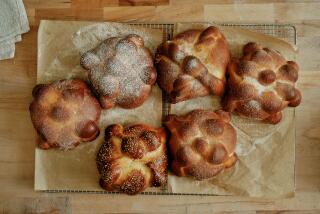The Big Bakersfield Basque Bash
- Share via
Bakersfield may seem like an unlikely destination on Memorial Day weekend. The air is oppressively hot, and Highway 99 shimmers through town in an endless succession of mirages. Yet travelers who veer off the freeway will soon find good reason to spend a few hours in the center of the Golden State’s agricultural heartland: the annual Basque Memorial Day Picnic at the Kern County Basque Club.
On this particular Sunday, the local Basque community holds its annual celebration, and Basques from far and wide gather to participate in the festivities--the Bernals, the Etchamendys, the Mendiburus and the Ansolabeheres, to name a few--all descendants of the original Basque immigrants who settled in California decades ago.
Early in the morning, a mass is held--in Euskara, the Basque language, of course. A lively parade follows, and the air reverberates with the sound of Basque songs and effervescent greetings. By lunchtime, the air wafting through the shady picnic grounds behind the club house is pungent with the scent of lamb chops grilling on giant barbecues. Vats of pinto beans and lamb stew simmer gently in large caldrons.
The food reflects the heritage of these descendants of Basque sheepherders. Today, they are dressed in traditional regalia. Dainty starched petticoats hold stiff the women’s multi-layered red skirts. Men sport cocky berets, waists tightly wrapped in cummerbunds of green or red, the Basque national colors. Soon, a long line snakes past the food stands, as plates are mounded with grilled meat and beans, chunks of crusty bread, generous pieces of homemade cheese and mountains of greens.
Everywhere, the guttural sounds of the Basque language float over the crowd. Here, conversations take place not only in Euskara and English, but also in Spanish and French. The country the Basques call home, after all, straddles the Pyrenees Mountains that separate France from Spain. Most of these Basque-Americans’ ancestors settled in Kern County because they found in the foothills of the Sierras and in the area around Bakersfield the same rugged terrain as in their beloved Pyrenees. Like the old country, this area of California is particularly favorable to raising sheep.
When the sun reaches its peak, the younger generation takes center stage. Younger people dance for their elders, in light, rhythmical steps filled with ritual and symbolism, similar to those their ancestors performed. The entertainers disappear in a flurry of petticoats and swirling ribbons, only to be replaced by teams of men who take over the concrete cancha (court) for a spirited game of pelota (better known in this country as jai alai , Basque for “a merry time”), a fast-moving cross between handball and racquetball.
From the food to the pelota games, Basque tradition permeates this Memorial Sunday.
*
This recipe appears in “From the Sheepcamp to the Kitchen,” by the Kern County Wool Growers Auxiliary.
KATIE BERNAL’S LENTILS FOR SHEEPCAMP 2 cups lentils, picked over and rinsed 8 cups beef stock 1 large onion, chopped 1 green pepper, seeded and cut into chunks 2 cloves garlic, minced 6 slices bacon, coarsely diced 3/4 cup tomato sauce Salt, pepper
Place lentils, stock, onion, green pepper, garlic, bacon, tomato sauce and salt and pepper to taste in large soup pot. Cover tightly and cook over medium heat 1 1/2 to 2 hours. Makes 6 to 8 servings.
Each of 6 servings contains about: 369 calories; 1214 mg sodium; 11 mg cholesterol; 11 grams fat; 44 grams carbohydrates; 27 grams protein; 3.77 grams fiber.
*
This recipe is a personal favorite of Louisa Etchamendy of Bakersfield. She likes to serve these peppers with warm gazpacho--a potato salad--as an accompaniment.
LOUISA ETCHAMENDY’S LAMB-STUFFED PEPPERS 6 to 8 medium green peppers 1 1/2 pounds ground lamb 1 tablespoon olive oil 2 cloves garlic, minced 1 (4-ounce) can diced green chiles 1 cup puffed rice cereal, crushed 2 teaspoons salt 1 teaspoon dried basil leaves 1 egg, lightly beaten 1 (6-ounce) can tomato paste 1/2 cup red wine or broth
With sharp knife, remove and discard top of each green pepper. Rinse peppers under running water, removing seeds. Set aside in colander to drain.
Meanwhile, combine ground lamb, olive oil, garlic, green chiles, rice cereal, salt, basil and egg in medium bowl. Mix well. Stuff each pepper with equal amounts of mixture. Set stuffed peppers upright in 13x9-inch baking dish.
Mix together tomato sauce and wine in small bowl and pour over each pepper. Cover baking dish with foil. Bake at 350 degrees 1 1/2 hours, then remove foil. Continue baking until peppers are browned, 10 to 15 minutes longer. Makes 6 to 8 servings.
Each of 6 servings contains about: 202 calories; 1,036 mg sodium; 91 mg cholesterol; 8 grams fat; 10 grams carbohydrates; 20 grams protein; 0.60 gram fiber.
*
“We like this salad served warm, but it is also wonderful cold, and leftovers never last very long,” Etchamendy says of this gazpacho recipe handed down from her grandmother, a native of Northern Spain. Those familiar with Spanish cuisine will find this potato salad quite a departure from the cold, tomato-based soup called gazpacho which is served in other regions of Spain. Steaming potatoes rather than boiling them ensures a firmer vegetable, says Etchamendy.
MARTA OSLE’S BASQUE GAZPACHO 6 large new potatoes 1/4 cup cider vinegar 2/3 cup olive oil 2 teaspoons salt 2 cloves garlic, minced 1 medium onion, thinly sliced 1 sweet red pepper, seeded and thinly sliced
In steamer filled with 2 inches of water, steam potatoes until tender, about 35 to 40 minutes. Add more water if necessary. When potatoes are done, drain and peel while still warm. Cut into 1/2-inch cubes. Place cubes in serving bowl.
Combine vinegar, olive oil, salt and garlic in medium bowl. Toss with potatoes and let stand 5 minutes. Toss again and mix in onion and sweet red pepper. Serve warm or at room temperature. Makes 6 to 8 servings.
Each of 6 servings contains about: 342 calories; 793 mg sodium; 0 cholesterol; 24 grams fat; 31 grams carbohydrates; 3 grams protein; 0.63 gram fiber.
*
Marguerite Ferdinand is an authority on the cuisine of her Basque countrymen. When called upon to bring a dessert to family gatherings, she often prepares this flan-like custard. BASQUE CUSTARD (Esnopila) 1 1/4 cups sugar 2 tablespoons water 4 cups milk 1 teaspoon grated orange zest 1 cinnamon stick 8 eggs, well beaten 1 teaspoon Cointreau or orange-flavored liqueur 2 tablespoons rum 1 tablespoon vanilla
Mix 1/2 cup sugar with water in small enamel saucepan and stir until dissolved. Cook over low heat until mixture caramelizes, 15 to 20 minutes. Be careful caramel doesn’t burn. Evenly cover bottom of 8-inch-square baking pan with caramelized sugar. Set aside.
Meanwhile, combine milk with remaining sugar, orange zest and cinnamon stick in large saucepan and cook over medium heat until milk is scalded. Strain hot milk and set aside to cool. Add cooled milk to beaten eggs in steady stream, stirring constantly. Stir in Cointreau, rum and vanilla.
Pour egg mixture into caramel-covered baking pan, then place inside larger pan filled with 1 inch water. Bake custard at 375 degrees until firm, 40 to 45 minutes. Remove from oven. Cool completely. To serve, invert custard carefully onto deep serving plate, since caramel will form sauce. Makes 8 to 10 servings.
Each of 8 servings contains about: 273 calories; 124 mg sodium; 222 mg cholesterol; 7 grams fat; 38 grams carbohydrates; 10 grams protein; 0 fiber.


